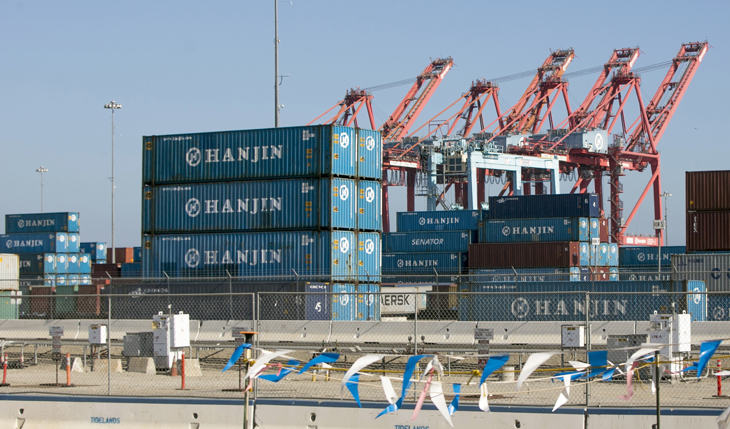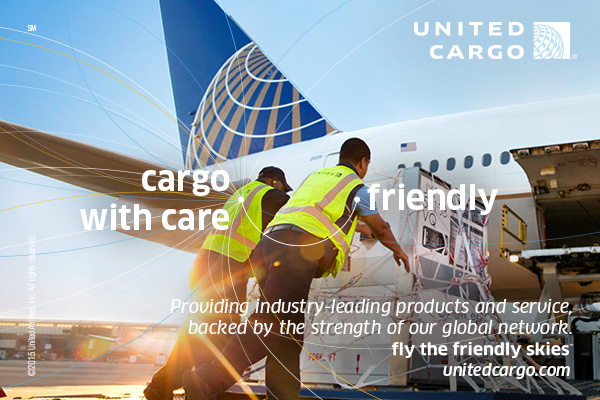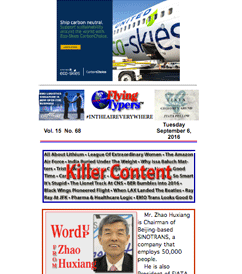
Hanjin Shipping’s
entry into receivership at the end of August left global
ocean supply chains in a spin. Could the fallout see
the air cargo market benefit?
You might ask a forwarder,
but the immediate answer points to the nightmare of
possibly having to pay twice for shipping the same goods.
“We pay upfront
to Hanjin and they go into receivership, so when we
finally find the goods locked up somewhere, in some
cases we have to pay again.
“Sure, we have insurance,
but what a mess right now!” FT was told.
 |
 Long
Slow Descent Long
Slow Descent
Hanjin, the world’s
seventh largest container line, was struggling financially
for some time before its creditors finally pulled the
plug. But despite the warning signs, the transport sector
was still left in shock. After
all, the world’s leading box shipping companies
survived the 2009 global financial crisis and the subsequent
long-term downturn in rates through a combination of
cost cuts, the formation of alliances, M&A consolidation,
and government assistance.
The demise of Hanjin has
left cargo and the Korean line’s ships stranded
around the world. As things stand, many terminals are
refusing to release Hanjin containers and cargo, or
will only do so on payment of large fees. Haulers are
also refusing to truck the line’s boxes and some
ports will not receive the company’s ships.
Customers able to secure
their cargoes are now urgently scrambling for space
as they seek to reach key markets in Europe and the
U.S. in time for the holiday season.
Rates
Impacted
The World Container Index
reported that spot rates from Shanghai to Los Angeles
in the U.S. and Rotterdam in Europe increased by 42
percent and 39 percent respectively on September 1 against
the previous week. Transpacific spots rates have also
spiked in recent days.
The knock-on effect for
air cargo markets could prove lucrative, with some $14bn
worth of goods thought to be stranded at sea.
“Many shippers and
forwarders are looking for alternative slots from others
carriers, but space is tight,” said Paul Tsui,
managing director of forwarding and logistics operator
Janel Group and the immediate past chairman of the Hong
Kong Association of Freight Forwarding and Logistics
and the Federation of Asia Pacific Aircargo Associations.
“Additional air
movements are quite possible as some of the cargo delayed
due to Hanjin’s problems will now need to be flown,
or replacements for cargo stranded at docks will need
to be air lifted.”
Customers
Scrambling
Stifel’s John Larkin
said Hanjin’s customers were scrambling to reposition
cargo and ensure timely delivery of freight, but due
to the web of vessel-sharing agreements in which Hanjin
is involved repositioning was no easy feat.
“With peak season
looming, and with echoes of last year's West Coast port
strike still fresh in shippers’ minds, we believe
many will be turning to freight forwarders and air cargo
capacity providers, if necessary, to find options and
alternatives,” he added.
 |
Kerr
Sees The Light
Indeed, tentative early
signs suggest the air freight sector is already benefitting.
Etihad Cargo Senior Vice President David Kerr told FlyingTypers
the carrier had received a number of charter enquiries
in recent days. “We are responding to these with
options for full and part charter of freighters, with
increased aircraft gauge and frequency to accommodate
demand on existing scheduled main deck and bellyhold
routes,” he said.
“Slot constraints
in China for new operations, both scheduled and charter,
are creating an artificial bottleneck.
“We already have
medium-term commitments in place with key retailers,
which will limit short-term availability. In general,
though, we anticipate oversupply of capacity—especially
in marine shipping, but also to an extent in air freight—will
absorb much of the demand.”
Lufthansa
Reinforcing
A spokesperson for Lufthansa
Cargo said the carrier was ready to reinforce routes
at short notice if there was high additional demand
in the weeks ahead. “The U.S. port strike in 2015
generated additional air freight business,” he
added. “However, it should be distinguished between
no ship leaving any harbor across a huge region, and
one single potentially leaving a market characterized
by overcapacities.”
Korean
Air Glad To Be Happy
The main air freight beneficiary
of the chaos engulfing Hanjin Shipping is likely to
be Korean Air, not least due to new product launches
planned by leading Korean companies that have been hit
by the line’s entry into receivership. Samsung
alone is reported to have some $38m worth of freight
sitting on Hanjin ships and is understood to be considering
chartering multiple freighters to meet its commitments
to customers.
A spokesperson for Korean
Air said due to internal regulations she was unable
to comment about the impact Hanjin’s demise has
had on demand—KAL is also part of the Hanjin Group.
KAL has, however, already pledged to increase flights
to Europe and the U.S.
Yet any short-term gains
in air freight shipments are likely to be dwarfed by
KAL’s exposure to Hanjin Shipping due its 33.23
percent stake in the company. The airline’s losses
on its loans and equity stake in the line are forecast
to total $344m, around a third of the carrier’s
projected operating income this year.
Lehman
Brothers Scenario
 Hanjin
Shipping’s bankruptcy continues to have far-reaching
implications for the container shipping industry and
global supply chains as retailers gear up for the holiday
season. The extent of the disruption was succinctly
captured by Gerry Wang, chief executive of Seaspan Corporation,
a shipowner with multiple vessels on charter to the
Korean line. Hanjin
Shipping’s bankruptcy continues to have far-reaching
implications for the container shipping industry and
global supply chains as retailers gear up for the holiday
season. The extent of the disruption was succinctly
captured by Gerry Wang, chief executive of Seaspan Corporation,
a shipowner with multiple vessels on charter to the
Korean line.
“The fallout of
Hanjin Shipping is like Lehman Brothers to the financial
markets,” he said. “It’s a huge, huge
nuclear bomb. It shakes up the supply chain, the cornerstone
of globalization."
Some 93 Hanjin vessels—79
of them container ships—are currently stranded
at 51 ports in 26 countries. Although Hanjin’s
owners (including Korean Air) are injecting funds to
help the company offload cargo and dock at terminals,
it will take some time, and potentially many lawsuits,
before all the freight in Hanjin’s supply chain
is returned to its rightful owners.
“You are talking
about $120bn worth of goods on ships that are stuck
. . . there is a material impact to the supply chain
and people are suffering from the consequences,”
said Wang.
Shippers and forwarders
are understandably seeking alternative shipping slots
for their cargoes and this has seen freight rates on
East-West trades into Europe and the U.S. spike. Lines
including Maersk and MSC have also launched new Trans-Pacific
services to fill the gap left by Hanjin.
Keeping
Customers Informed
 Cas
Pouderoyen, SVP of Global Ocean Freight at Agility,
said the logistics specialist was taking special measures
to ensure customers with cargo stuck in Hanjin’s
network were kept fully informed. Cas
Pouderoyen, SVP of Global Ocean Freight at Agility,
said the logistics specialist was taking special measures
to ensure customers with cargo stuck in Hanjin’s
network were kept fully informed.
“We are proactively
providing updates on cargo location and status twice
a day to customers eager for information,” he
said. “Offloading and transshipping are options
for those who require shipments urgently, but due to
the additional cost, not all customers are choosing
to stop cargo at transshipment ports.
“We are also assisting
clients with moving containers from the discharge port
to the final destination via expedited truck services.”
So far reports from the
airline and forwarding industry about the impact of
Hanjin's demise on air freight demand out of Asia are
mixed, although demand does appear to be generally tilting
upwards.
"The run-up to the
holiday season is a crucial time for retailers and,
in some cases, we are working with customers to provide
them with air freight options to ensure their deadlines
are met,” said Pouderoyen.
Indeed, he said time-
sensitive customers were already moving to air, although
this was not expected to be a long-term trend and would
be diluted as more vessel options and capacity came
on stream over the coming weeks and months.
"If this crisis does
continue beyond September, we believe our customers
will look for alternative shipping models, however,
the general consensus for now seems to be ‘wait
and see,’” he said.
“Customers still
need time to assess their individual situation and see
if they have enough stocks to replace the Hanjin stranded
containers and goods. If they do, they might still have
enough time to use alternative solutions such as sea-air
or rail-air to Europe, and if they don’t have
enough stock and need to manufacture first, then a rush
on airfreight may well happen to bring the goods to
Europe and the U.S. in time for the end year business."
More
Air
A spokesperson for Cargolux
said the freighter giant had not seen a significant
increase in charter demand related to the Hanjin Shipping
situation specifically, but there had been an overall
healthy increase in demand both for regular flights
and charters. “It might still be too early to
gauge the immediate effect of the Hanjin receivership,”
he added. “The Korean government seems to have
regulated the capacity and also has taken care of the
port congestion.
“We are now in the
Korean thanksgiving holiday period that will last until
September 18. Maybe we can see more developments after
that.”
A spokesman for China
Airlines said the collapse of Hanjin Shipping had seriously
disrupted sea freight services. “Though a few
cargo owners needing to ship from Asia to the U.S. switched
to air freight, most of these have been absorbed by
existing capacity on the market,” he explained.
“Q4 has traditionally
been the peak season for freight and for U.S. retailers
building up their end-of-year inventories. While China
Airlines had existing plans in place to adjust capacity
and fees, if the shortage of sea freight capacity persists
this may prevent merchandise traveling from Asia to
the U.S. being delivered in time for the Thanksgiving
and Christmas shopping season for retailers.
“In other words,
there may be a significant increase in demand from urgent
freight traveling by air rather than by sea.
“China Airlines
will continue to monitor changes in cargo volumes and
hold utilization on U.S. routes and trends in air freight
rates in order to adjust our capacity and rates based
on market demand.”
SkyKing |











 Long
Slow Descent
Long
Slow Descent 
 Hanjin
Shipping’s bankruptcy continues to have far-reaching
implications for the container shipping industry and
global supply chains as retailers gear up for the holiday
season. The extent of the disruption was succinctly
captured by Gerry Wang, chief executive of Seaspan Corporation,
a shipowner with multiple vessels on charter to the
Korean line.
Hanjin
Shipping’s bankruptcy continues to have far-reaching
implications for the container shipping industry and
global supply chains as retailers gear up for the holiday
season. The extent of the disruption was succinctly
captured by Gerry Wang, chief executive of Seaspan Corporation,
a shipowner with multiple vessels on charter to the
Korean line. Cas
Pouderoyen, SVP of Global Ocean Freight at Agility,
said the logistics specialist was taking special measures
to ensure customers with cargo stuck in Hanjin’s
network were kept fully informed.
Cas
Pouderoyen, SVP of Global Ocean Freight at Agility,
said the logistics specialist was taking special measures
to ensure customers with cargo stuck in Hanjin’s
network were kept fully informed.
